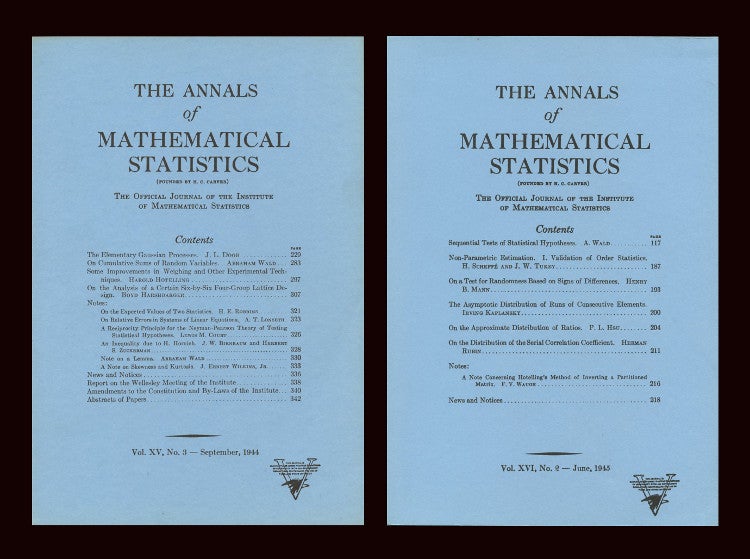On Cumulative Sums of Random Variables (Annals of Mathematical Statistics 15 No. 3 pp. 283 – 296, September 1944) and Sequential Tests of Statistical Hypotheses (Annals of Mathematical Statistics 16 No. 2 pp. 117 -186, June 1945).
1st Edition. FIRST EDITIONS IN MINT CONDITION AND IN ORIGINAL WRAPS of Abraham Wald’s seminal work on sequential tests of statistical hypotheses.
Before Wald, the traditional style of statistical decision was to posit a hypothesis, make a predetermined number of measurements, then make a decision whether to accept or reject the hypothesis. Wald realized that this procedure is quite wasteful, and that many measurements could be saved if given the option to decide at every step whether to continue or stop the measurement process. "According to Wald, the resulting ‘sequential probability ratio test frequently results in a savings of about 50 percent in the number of observations over the most efficient test procedure based on a fixed number of observations" (Gass, An Annotated Timeline of Operations Research, 65). In these papers Wald, known now as "the father of sequential analysis and decision theory," first presents the theoretical foundations of the theory of sequential analysis. The ideas he put forth revolutionized the art of statistical testing and were later developed in the hands of computer scientists into a field known as on-line algorithms (Blom, Problems and Snapshots, 203).
"Probability theory came of age with the advent of Kolmogorov's axiomatics in 1933 and the subsequent developments in limit theorems and stochastic processes. Statistical inference came of age with the advent of the Neyman-Pearson theory in 1933 and the subsequent formalization of hypothesis testing, estimation, and decision theory. In these papers, Wald elegantly unified two seemingly dissimilar areas: probability theory and statistical inference. To probabilists, he offered gems of new results in random walks, martingales, stochastic processes, and limit theorems. He also pointed out indirectly how one might seek probability questions from statistical inference, the use the latter area as a testing ground for their abstract theorems.
To statisticians, Wald showed that statistical inference is not just the analysis or 'significance' of an existing body of data; it also entails their entry into the very process of experimentation and continual analysis of the data as they come available. The sequential probability ratio test embodies this aspect. Wald also showed them how results from 'pure' mathematics, particularly probability theory, can be adapted to put statistical inference, in general, on stronger footing without losing sight of its practical nature." (Kotz & Johnson: Breakthroughs in Statistics).
Wald's work was conceived in 1943 at Columbia. He was asked by the Navy’s Bureau of Ordnance if there was a sampling plan that could terminate a statistical experiment earlier than planned. Wald’s theoretical results first appeared in September 1943, but in the form of a 'restricted' report, meaning that the Defense Department considered the results significantly important for the war effort and, therefore, decided not to disseminate them to the general public for a while. The report was 'declassified' in early 1945, thereby allowing the present paper to appear in June of that year. Interestingly enough, Wald had already (in his paper 'On Cumulative Sums of Random Variables' from 1944 and also offered here), published many of the mathematical foundations of sequential procedures without any mention of the word sequential or any reference to his 1943 report, as was called for in the protocol. Item #96
CONDITION & DETAILS: 4to. 10 X 7 inches (250 x 175mm). Each issue is bound in original blue wraps and is in mint condition in every way.
Price: $1,175.00

